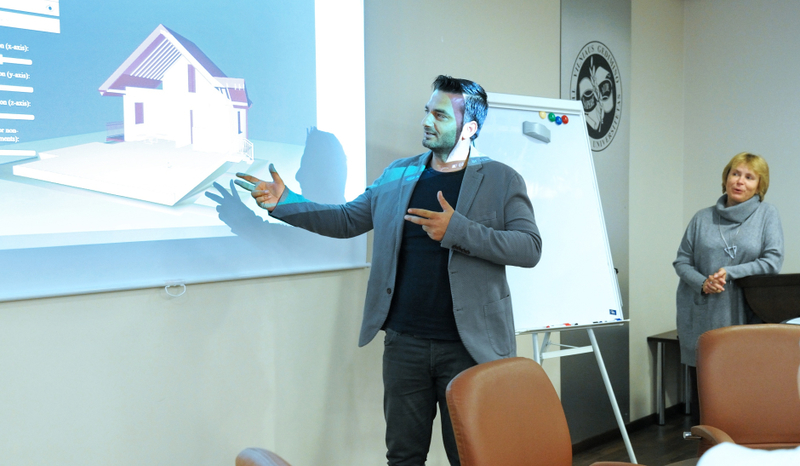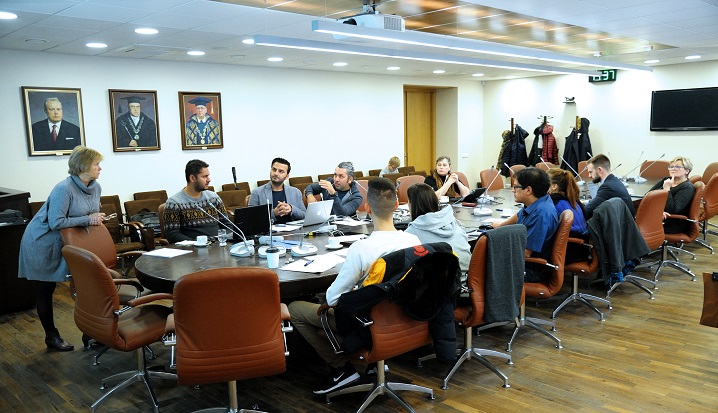Home
For international students
Erasmus+ Cooperation for innovation and the exchange of good practices
- Programmes in English 2025/2026
- Admission 2024/2025 Scholarships
- For exchange students
- Free Movers
- Transfer studies
- Erasmus+ studies and traineeships
- Mentor programme
- Student testimonials
- Accommodation
- Career Services
- Medical Care
- Immigration Regulations
- Leisure and Student Activities
- Useful information
- VILNIUS TECH for Creators of Tomorrow
- Mental and spiritual support
- Representatives Abroad
- Contacts
- Computer Engineering

2019-10-18
Erasmus+ Cooperation for innovation and the exchange of good practices
The project “Development of a virtual learning environment in technical higher education” jointly funded by the Erasmus program for 24 months, and includes institutions from five countries: Estonia, Lithuania, Turkey, Poland and Croatia.
The 3rd Team meeting and first Learning, Teaching and Training (LTT) activity of the VIRTEC project, which started in October 2018, was carried out at VGTU between the dates of 7-12 October. Participating in project partner teams come from Lithuania, Estonia, Turkey, and Croatia. Croatian team has successfully entered the working pace and introduced fresh constructive ideas to the project.
The meeting focus was overview and evaluation of the results achieved, as well as activities for the next period of the project.
During the LTT activities, the partners had workshops on:
● demonstrations of exercises,
● tests usage,
● overview of tests,
● exercises creating' possibilities (using HP5, Hot Potato, Moodle'),
● summary of simulation' possibilities and programming,
● simulators' created functions' evaluation and new opportunities,
● overview of worksheets' creating' possibilities,
● overview of the options of game exercises for testing knowledge.

The project objectives are as following:
-to achieve labour force compatible and able to fulfil the expectations of companies and therefore raise the economic success of participating countries by developing a stable platform for educating students in the field of construction and architecture,
-to achieve an increase in the quality of education and training,
Through the integration of emerging simulations technologies and graphic techniques
-to provide a vibrant virtual learning environment for students who have no experience in the construction industry to be implemented as part of the work-based learning and a mobility component,
-addressing learning outcomes and proper recognition and validation of the learning achievements,
-to positively influence the change in the level of preparation of students in construction and architectural specialties in partners' countries,
-to create a base for collaboration network that enables to make cooperation in designing courses and adopting new teaching methodologies and change information and knowledge,
-to develop and test the effectiveness of the imitative presentation of the component parts of the house and its various modifications for use in education in the field of construction and architecture in order to increase interest and support the participation of students.
Each partner country team has different tasks in the project. The Turkish side is in charge of modelling different parts of the simulators' house and programming. Estonia prepared virtual simulator and student self-evaluation exercises and tasks. Lithuania team continued to work on the 3D model of the house. Newly introduced Croatian partner started work on the dissemination plan and the promotion for the simulator.
The partners attended the lecture of our university, where students were introduced with the VIRTEC simulator and had a chance to take the "hot potato" and other tests. After the class, students answered the survey on how useful our software for their study process is. Students' positive feedback will help in the further development of the simulator.
Site of the project is here
The 3rd Team meeting and first Learning, Teaching and Training (LTT) activity of the VIRTEC project, which started in October 2018, was carried out at VGTU between the dates of 7-12 October. Participating in project partner teams come from Lithuania, Estonia, Turkey, and Croatia. Croatian team has successfully entered the working pace and introduced fresh constructive ideas to the project.
The meeting focus was overview and evaluation of the results achieved, as well as activities for the next period of the project.
During the LTT activities, the partners had workshops on:
● demonstrations of exercises,
● tests usage,
● overview of tests,
● exercises creating' possibilities (using HP5, Hot Potato, Moodle'),
● summary of simulation' possibilities and programming,
● simulators' created functions' evaluation and new opportunities,
● overview of worksheets' creating' possibilities,
● overview of the options of game exercises for testing knowledge.

The project objectives are as following:
-to achieve labour force compatible and able to fulfil the expectations of companies and therefore raise the economic success of participating countries by developing a stable platform for educating students in the field of construction and architecture,
-to achieve an increase in the quality of education and training,
Through the integration of emerging simulations technologies and graphic techniques
-to provide a vibrant virtual learning environment for students who have no experience in the construction industry to be implemented as part of the work-based learning and a mobility component,
-addressing learning outcomes and proper recognition and validation of the learning achievements,
-to positively influence the change in the level of preparation of students in construction and architectural specialties in partners' countries,
-to create a base for collaboration network that enables to make cooperation in designing courses and adopting new teaching methodologies and change information and knowledge,
-to develop and test the effectiveness of the imitative presentation of the component parts of the house and its various modifications for use in education in the field of construction and architecture in order to increase interest and support the participation of students.
Each partner country team has different tasks in the project. The Turkish side is in charge of modelling different parts of the simulators' house and programming. Estonia prepared virtual simulator and student self-evaluation exercises and tasks. Lithuania team continued to work on the 3D model of the house. Newly introduced Croatian partner started work on the dissemination plan and the promotion for the simulator.
The partners attended the lecture of our university, where students were introduced with the VIRTEC simulator and had a chance to take the "hot potato" and other tests. After the class, students answered the survey on how useful our software for their study process is. Students' positive feedback will help in the further development of the simulator.
Site of the project is here











